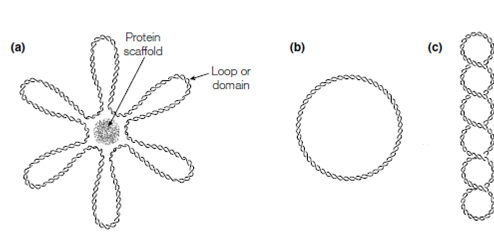Prokaryotic chromosomes:
The DNA of a bacterial cell, like as Escherichia coli is a circular double-stranded molecule frequently referred to as the bacterial chromosome. The circular DNA is packaged into a region of the cell known as the nucleoid where it is organized into 50 or so loops or domains which are bound to a central protein scaffold attached to the cell membrane. Above figure illustrates these industries, although only six loops are shown for clarity. Within this structure the DNA is in fact not a circular double-stranded DNA molecule like as that shown in fig.1b but is negatively supercoiled, which is, it is twisted upon itself and is also complexed with various DNA-binding proteins, the most common of that are proteins HU, H-NS and HLP-1. These are histone-like proteins.

figure: (a) The association of circular bacterial DNA with a protein scaffold; (b) a circular double-stranded DNA molecule; (c) supercoiled DNA.